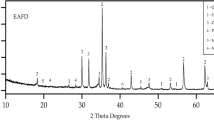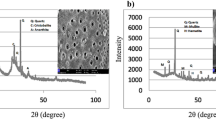Abstract
The characteristics of vast dune sands in southern Algeria create the potential for exploitation in high-temperature resistance performances for refractory mortar manufacturing used in building construction. The refractory mortar examined in this work incorporates amounts of fine addition of liquid crystal display glass electronic waste (DGE-waste) in order to optimize the thermophysical and mechanical performance of the mortar and correct the granular distribution of the used sand. The aim of this paper is to study new refractory mortar products containing DGE-waste to reduce the demand for conventional mortars while providing a new sustainable waste management solution. The dune sand was partially substituted (0 %, 5 %, 10 %, 15 %, and 20 % in weight) with DGE-waste powder with a w/c ratio of 0.6. The DGE-waste powder and four of the five samples were analyzed using a scanning electron microscope (SEM). The thermophysical properties, such as thermal conductivity, were experimentally measured in dry states. These properties were determined as a function of the DGE-waste powder percentage using a high-temperature oven at different temperatures (200 °C, 400 °C, 600 °C, and 800 °C), whose mechanical behavior at high temperatures has not been extensively studied. We statistically analyzed the obtained data using one-way analysis of variance (ANOVA) with a level of significance of 0.05. The results confirm that increasing the replacement levels of additions of DGE-waste significantly improves the thermo-physical and thermo-mechanical properties of dune sand-based mortar. As a result, the results show that thermal conductivity decreases with increasing temperature and/or decreased replacement rate. Therefore, the incorporation of DGE-waste powder can significantly affect the thermophysical and thermomechanical properties as compared with the control mortar. The results revealed that a more reasonable way to find refractory dune sand mortar is by incorporating DGE-waste.















Similar content being viewed by others
Data Availability
The authors confirm that all the data supporting the findings of this study are available in this paper.
References
P.G. Goh, M. Maghfouri, C.C. Onn, S.C. Loo, Life cycle assessment on recycled e-waste concrete. Case Stud. Constr. Mater. 17, e01412 (2022). https://doi.org/10.1016/j.cscm.2022.e01412
V.M. Divyadharshini, D. Karthickraja, R.P. Thamilselvan, S. Elavarasan, V. Yogeshwaran, Experimental studies on partial replacement of E-waste and Blast Furnace Slag in concrete. Mater. Today: Proc. 62, 2000–2004 (2022). https://doi.org/10.1016/j.matpr.2022.02.289
N. Sharma, P. Sharma, A.K. Parashar, An experimental investigation of sustainable concrete by incorporating e-waste and fly ash. Mater. Today: Proc. 62, 4188–4193 (2022). https://doi.org/10.1016/j.matpr.2022.04.704
S. Ullah, M.I. Qureshi, P. Joyklad, S. Suparp, Q. Hussain, K. Chaiyasarn, E. Yooprasertchai, Effect of partial replacement of E-waste as a fine aggregate on compressive behavior of concrete specimens having different geometry with and without CFRP confinement. J. Build. Eng. 50, 104151 (2022). https://doi.org/10.1016/j.jobe.2022.104151
Z. Ullah, M.I. Qureshi, A. Ahmad, S.U. Khan, M.F. Javaid, An experimental study on the mechanical and durability properties assessment of E-waste concrete. J. Build. Eng. 38, 102177 (2021). https://doi.org/10.1016/j.jobe.2021.102177
F. Ahmad, M.I. Qureshi, Z. Ahmad, Influence of nano graphite platelets on the behavior of concrete with E-waste plastic coarse aggregates. Constr. Build. Mater. 316, 125980 (2022). https://doi.org/10.1016/j.conbuildmat.2021.125980
K. Hamsavathi, K. Soorya Prakash, V. Kavimani, Green high strength concrete containing recycled cathode ray tube panel plastics (E-waste) as coarse aggregate in concrete beams for structural applications. J. Build. Eng. 30, 101192 (2020). https://doi.org/10.1016/j.jobe.2020.101192
P. Lamba, D.P. Kaur, S. Raj, J. Sorout, Recycling/reuse of plastic waste as construction material for sustainable development: a review. Environ. Sci. Pollut. Res. (2021). https://doi.org/10.1007/s11356-021-16980-y
H.A. Shahane, S.S. Bhosale, E-Waste plastic powder modified bitumen: rheological properties and performance study of bituminous concrete. Road Mater. Pavement Des. (2021). https://doi.org/10.1080/14680629.2019.1642944
M.H. Rahman Sobuz, A. Saha, A.S. Mohammad Akid, T. Vincent, V.W.Y. Tam, Ç. Yalçınkaya, R. Mujahid, N.M. Sutan, Performance of self-compacting concrete incorporating waste glass as coarse aggregate. J. Sustain. Cem. Based Mater. (2022). https://doi.org/10.1080/21650373.2022.2086936
B. Balasubramanian, G.V.T. Gopala Krishna, V. Saraswathy, K. Srinivasan, Experimental investigation on concrete partially replaced with waste glass powder and waste E-plastic. Constr. Build. Mater. 278, 122400 (2021). https://doi.org/10.1016/j.conbuildmat.2021.122400
S. Shrivastava, Durability analysis and optimization of a binary system of waste cement concrete and glass-based geopolymer mortar. J. Mater. Cycl. Waste Manage. 24, 1281–1294 (2022). https://doi.org/10.1007/s10163-022-01400-1
O.M. Olofinnade, A.N. Ede, J.M. Ndambuki, Experimental investigation on the effect of elevated temperature on compressive strength of concrete containing waste glass powder. Int. J. Eng. Technol. Innov. 7, 280 (2017)
D. Grdić, I. Despotović, N. Ristić, Z. Grdić, G.T. Ćurčić, Potential for use of recycled cathode ray tube glass in making concrete blocks and paving flags. Materials 15, 1499 (2022). https://doi.org/10.3390/ma15041499
M.I. Sayyed, N. Almousa, M. Elsafi, Green conversion of the hazardous cathode ray tube and red mud into radiation shielding concrete. Materials 15, 5316 (2022). https://doi.org/10.3390/ma15155316
K.-L. Lin, The effect of heating temperature of thin film transistor-liquid crystal display (TFT-LCD) optical waste glass as a partial substitute partial for clay in eco-brick. J. Clean. Prod. 15, 1755–1759 (2007). https://doi.org/10.1016/j.jclepro.2006.04.002
D.M. Al Saffar, T.A. Tawfik, B.A. Tayeh, Stability of glassy concrete under elevated temperatures. Eur. J. Environ. Civ. Eng. 26, 3157–3168 (2022). https://doi.org/10.1080/19648189.2020.1783368
S. Sasui, G. Kim, J. Nam, A. van Riessen, M. Hadzima-Nyarko, G. Choe, D. Suh, W. Jinwuth, Effects of waste glass sand on the thermal behavior and strength of fly ash and GGBS based alkali activated mortar exposed to elevated temperature. Constr. Build. Mater. 316, 125864 (2022). https://doi.org/10.1016/j.conbuildmat.2021.125864
S.-K. Kim, I.-Y. Jang, H.-J. Yang, Strength development characteristics of concrete replaced with different waste glasses from display industry as a cementitious material. KSCE J. Civ. Eng. 24, 2485–2494 (2020). https://doi.org/10.1007/s12205-020-0223-y
H.-Y. Wang, T.-C. Hou, A study of elevated temperatures on the strength properties of LCD glass powder cement mortars, in Integrated Waste Management, vol. I, ed. by S. Kumar (Intechopen, London, 2011). https://doi.org/10.5772/17721
A. Ghrieb, Y. Abadou, The use of crushed ceramic waste as granular corrector in the manufacture of the mortars based on dune sand. J. Eng. Sci. Technol. Rev. 11, 126–131 (2018). https://doi.org/10.25103/jestr.114.16
M. Malešev, V. Radonjanin, I. Lukić, V. Bulatović, The effect of aggregate, type and quantity of cement on modulus of elasticity of lightweight aggregate concrete. Arab. J. Sci. Eng. 39, 705–711 (2014)
T. Gupta, S. Chaudhary, R.K. Sharma, Mechanical and durability properties of waste rubber fiber concrete with and without silica fume. J. Clean. Prod. 112, 702–711 (2016)
RILEM-TC-129, Recommendation of RILEM TC 200-HTC: mechanical concrete properties at high temperatures—modelling and applications. Mater. Struct. 40, 855–864 (2007)
P. Chindaprasirt et al., Thermal insulating and fire resistance performances of geopolymer mortar containing auto glass waste as fine aggregate. J. Build. Eng. 60, 105178 (2022). https://doi.org/10.1016/j.jobe.2022.105178
G.A. Khoury, Compressive strength of concrete at high temperature: a reassessment. Mag. Concr. Res. 44, 291–309 (1992)
I.H. Gaweska, High temperature behavior of high performance concretes - evolution of the main mechanical properties. PhD thesis, National School of Bridges and Roads, Paris/Marne la Vallée and Polytechnic School of Krakow, 2004.
W.M. Lin, T.D. Lin, Powers-Couche, microstructures of fire-damaged concrete. ACI Mater. J. 93, 199–205 (1996)
B. Demirel, O. Keleştemur, Effect of elevated temperature on the mechanical properties of concrete produced with finely ground pumice and silica fume. Fire Saf. J. 45, 385–391 (2010)
T.T. Lie, Fire and buildings (Applied Science Publishers Ltd., London, 1972)
M. Adamu, Y.E. Ibrahim, H. Alanazi, Evaluating the influence of elevated temperature on compressive strength of date-palm-fiber-reinforced concrete using response surface methodology. Materials 15, 8129 (2022). https://doi.org/10.3390/ma15228129
S.Q. Yang, T.C. Ling, H. Cui, C.S. Poon, Influence of particle size of glass aggregates on the high temperature properties of dry-mix concrete blocks. Constr. Build. Mater. 209, 522–531 (2019). https://doi.org/10.1016/j.conbuildmat.2019.03.131
N.J. Carino, Nondestructive test methods to evaluate concrete structures, in 6th CANMET/ACI International Conference on Durability of Concrete, Thessaloniki, Greece (2003)
Acknowledgements
The authors wish to express their gratitude to the structural and material laboratory tests (laboratory and public works office, ISO 9001:2015 certified laboratory).
Funding
The authors did not receive support from any organization for the submitted paper.
Author information
Authors and Affiliations
Contributions
TC carried out the experiment. AG was involved in planning and supervised the work. YA performed the analysis and drafted the manuscript with support from RB. All authors read and approved the final manuscript.
Corresponding author
Ethics declarations
Conflict of interest
The authors declare no conflict of interest.
Additional information
Publisher's Note
Springer Nature remains neutral with regard to jurisdictional claims in published maps and institutional affiliations.
Rights and permissions
Springer Nature or its licensor (e.g. a society or other partner) holds exclusive rights to this article under a publishing agreement with the author(s) or other rightsholder(s); author self-archiving of the accepted manuscript version of this article is solely governed by the terms of such publishing agreement and applicable law.
About this article
Cite this article
Choungara, T., Ghrieb, A., Abadou, Y. et al. A Statistical Approach for Green Conversion of the Amorphous E-waste into Glassy Refractory Mortar Subjected to High Temperature. Int J Thermophys 44, 44 (2023). https://doi.org/10.1007/s10765-023-03156-8
Received:
Accepted:
Published:
DOI: https://doi.org/10.1007/s10765-023-03156-8




